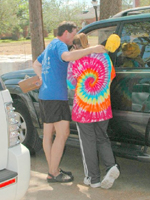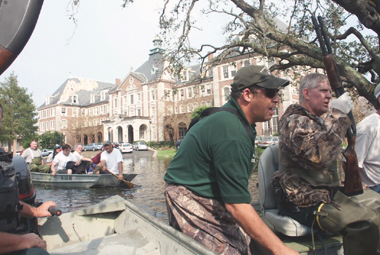The Association of Theological Schools, in collaboration with the Council for Christian Colleges and Universities and the Association for Biblical Higher Education, has set up a fund to help seminaries and Christian colleges affected by Hurricane Katrina. Donations may be sent to United Christian College Fund - Disaster Relief, 321 Eighth Street, N.E., Washington, DC 20002. For more information, call 202-546-8713.
 |
| Craig Price, New Orleans Baptist Theological Seminary's dean of students, prayed with student Maria Gowan on October 5 when she returned to campus to retrieve personal items from her dormitory. (PHOTO COURTESY NOBTS) |
More than a month after Hurricane Katrina made landfall in Louisiana, the city of New Orleans was still pitch-black at night. The only electric light came from the cross atop the chapel at New Orleans Baptist Theological Seminary. For both seminaries in New Orleans — the Baptist school and its Catholic counterpart, Notre Dame Seminary — being a beacon to the city is not a figurative gesture. Both schools were driven out of town by the storm and subsequent flooding. Both have struggled to salvage the fall semester and are now looking ahead to rebuilding and returning home to fulfill their mission.
New Orleans Baptist Theological Seminary
When Baptist theological seminary officials returned to their campus September 15, they found that none of the school's buildings appeared to have suffered structural damage. The main administration building and library were left untouched by the flooding. That was the good news. The bad news was that flooding took a toll on the residential buildings. Water swept through the lower floors, destroying personal property, leaving behind a layer of mud, and creating the perfect environment for mildew and mold. The school will need to replace all the wiring, drywall, and carpet on the first floors.
New Orleans Baptist is unusual in that more than half the faculty lives on campus. The weight of the tragedy hit home when the campus was opened for five days so that students and faculty could assess damage and retrieve personal items. The assessment was sobering: most of the faculty and about half the students lost everything.
"These were our five worst days," said seminary president Charles S. Kelley Jr., describing the return to campus. "I've never been prouder of a group of people in my whole life."
Now that the campus is empty again, school administrators are looking ahead. "We have three phases," said Dr.Kelley. "The first phase is the crisis phase, where you are basically dealing with survival issues. The second phase is the rebuilding phase. And the third phase is the coming-back-home phase." For Dr.Kelley, the students returning to gather their belongings closed the first phase. He is now focused on rebuilding.
The school's administrative offices and many of its classes moved to Atlanta in September. Offering students a variety of ways to finish their classes has salvaged the semester. They can take classes at one of the school's 17 extension sites, located in Atlanta, Baton Rouge, and other southeastern U.S. cities. The school has also made more than 20 classes available online.
Notre Dame Seminary
Notre Dame Seminary lies seven miles down Interstate 10 from New Orleans Baptist Theological Seminary. There, flooding in the wake of Hurricane Katrina created much the same story. When the order went out to evacuate the city, most students and faculty left the seminary. Several seminarians and Father Patrick Williams, the school's rector-president, stayed behind to keep the buildings secure and to be available to minister to the community afterward.

   |
| On September 1, state Senator Nick Gautreaux (in green shirt) led a team from the Louisiana department of wildlife and fisheries, which evacuated the remaining seminarians, priests and staff from Notre Dame Seminary. (PHOTO BY BRANDON BRISCOE) |
The night of the storm, the roof was damaged by the winds. In the morning, however, it seemed the worst had passed. Then the levees broke. As the water rose, those who remained rushed to move valuable library resources to safety. When gangs took over the bishop's home across the street, they knew it was time to leave.
Since then, the entire seminary has moved about 40 miles north to St. Joseph Seminary College in St. Benedict, Louisiana. Only the physical plant staff has remained on the New Orleans campus.
The executive committee of Notre Dame's board of trustees felt that remaining in the area was an important witness to the community. Also, they felt that it was important for students, engaged in local ministry, to continue to serve affected areas. The move to St. Benedict also made sense logistically, since students, faculty, and administrators can return to their campus when needs arise.
"When the storm hit, we had two goals in mind," said Father Williams. "One goal was to try and salvage the fall semester. The second was to maintain the integrity of our community and our program."
Student retention
Universities all over the country have opened their doors to students displaced by the storm, but the seminaries in New Orleans seem to have succeeded in retaining their students. So far, few students have transferred away.
At New Orleans Baptist Seminary, which had roughly 2,500 students at the beginning of the semester, only 44 have transferred. About 250 students have withdrawn from school temporarily to get their lives in order.
"Every student gets multiple contacts," said Dr. Kelley. "The dean of students calls to make sure they are safe and have a place to live. Then every professor is contacting every student on their roll. Sixty to 70 percent are enrolling in their fall classes in one of the five ways they set up to finish out the semester" — online, at extension locations on a normal schedule, at extension locations on Saturdays, as full-week workshops that convened in October, or as "threaded-discussion classes." The last operate much like an independent study, but with group discussion that is facilitated online via the Blackboard course management system.
Notre Dame Seminary is much smaller. Of the 110 seminarians that began classes at the Catholic seminary this fall, 13 have transferred to other schools such as St. Meinrad in Indiana and the Josephinum in Ohio. Another 15 students are in the deacon class and were working in parishes this semester. They were due to return to campus in November, but instead they are remaining in their internships through Christmas.
Role of trustees
Trustees, of course, are involved every time schools need to make big decisions. In a time of crisis, their role is even more critical. But Hurricane Katrina and the disaster that followed created an entirely unexpected situation that called trustees to an even deeper level of involvement.
"We had plans for evacuation and plans for securing the seminary," said Notre Dame's Father Williams, adding that there were no prior plans for relocating the entire school. "We had not foreseen this kind of traumatic event." Before moving the seminary to St. Joseph's, Father Williams wanted the consent of the board. Since the board could not meet as a whole, Williams brought proposals to the executive committee, which met by conference call and gave him authorization to go ahead with the move.
Trustee leadership far surpasses mere decision-making during significant natural disasters, however. The Rev. Mitch Hamilton, pastor of Mississippi Baptist Church in Aurora, Colorado, and a member of the Baptist seminary's board of trustees, believes that trustees must take on extraordinary responsibilities after a catastrophe of such magnitude. "Everyone was affected," he said. "The leadership themselves suffered great personal loss, so the situation was personally stressful even before decisions had to be made."
After talking with the dean of students, who was coordinating a five-day open house in which students and faculty retrieved their belongings from campus, Hamilton saw a place for trustees to step in. With President Kelley's approval, he called Southern Baptist Disaster Relief and other groups and asked if they could supply counselors and chaplains to minister to the returning students. Hamilton then flew to New Orleans to coordinate the efforts of volunteers that came to help.
Future
Leaders at both New Orleans Baptist and Notre Dame seminaries are optimistic about the future. As of October 7, the Baptist school had drinkable water, and power was on in the office buildings. They were still waiting for telephone service. Dr. Kelley plans to be back on campus in December or January. He also hopes to have a few classes on campus starting in January.
The seminary's board of trustees voted September 27 to keep the school in New Orleans. "I put the question on the table," said Dr. Kelley, telling his trustees that "if anyone ever wants to think about us leaving New Orleans, this is the time for you to say you would like us to think about that." During the hour-long discussion that followed, no one argued strenuously for leaving the city. "There was just this settled sense," he added, "even through the discussion, that we know this is where God wants us to be. "The issue of "sole membership," which affirms the school's ownership by the Southern Baptist Convention and which was reported in the summer 2005 issue of In Trust, did not affect the decision and will probably have no effect on rebuilding.
At Notre Dame Seminary, Father Williams plans to move back to campus in the new year. "By Thanksgiving, we will make a decision as to whether or not we can return in January," he said, adding that the seminary has been invited to remain in its temporary home through spring if necessary.
Over the next several months to a year, administrators and trustees will have a lot to do: insurance claims will be made, contractors will be consulted, and classes will be brought back to campus. Though Hurricane Katrina took its toll, both seminaries have emerged from the storm and its aftermath with a dogged determination to serve New Orleans, the community they call home.
Friday, August 26 1 a.m.: In the Gulf of Mexico, Katrina downgraded to a tropical storm. By 5 a.m. it is again a hurricane. Louisiana Governor Kathleen Blanco declares state of emergency.
Saturday, August 27 5 a.m.: Hurricane Katrina a Category 3 hurricane. Both campuses largely evacuated during weekend.
Sunday, August 28: Mayor Ray Nagin and Governor Blanco issue mandatory evacuation order for New Orleans. At NOBTS, two dozen people remain behind. At NDS, about a dozen students and clergy stay behind to look after the campus and minister to parish elderly.
Monday, August 29 6:10 a.m.: Makes landfall near Buras, LA. 145 mph winds. Late in the day, NOBTS buildings have roof damage, seminary chapel heavily damaged, older campus apartment building in 3 feet of water, numerous trees lost. Also, looting begins near NOBTS campus.
2 p.m.: Breach in 17th Street Canal levee confirmed.
Tuesday, August 30 1:30 p.m.: CNN reports 17th Street Canal levee suffered two-block- wide breach. Three levees breached. 80% of New Orleans under water.
Wednesday, August 31: Water continues to rise.
Wednesday, August 31: Governor Kathleen Blanco orders all of New Orleans evacuated. Police department ordered to abandon rescue efforts, work to control looting, enforce curfew. Remaining NOBTS staff leaves New Orleans by convoy, following a front-end loader to get through deep water that blocks access.
Thursday, September 1: NOBTS officials meet at temporary offices at extension center in Decatur, GA.
Friday, September 2: NDS seminarians and priests leave after spending day moving church documents into walk-in safes to protect them from looters. Artifacts include 6,000-year-old clay cuneiform tablets from seminary library.
September 23—30: Seminarians return to NDS to secure books and belongings.
Tuesday, September 27: NOBTS trustees vote unanimously to remain in New Orleans. NDS temporarily relocated to St. Joseph Seminary College in St. Benedict, LA.
Monday, October 3: Classes resume at both campuses.
October 5—9: NOBTS open for retrieval of personal items.